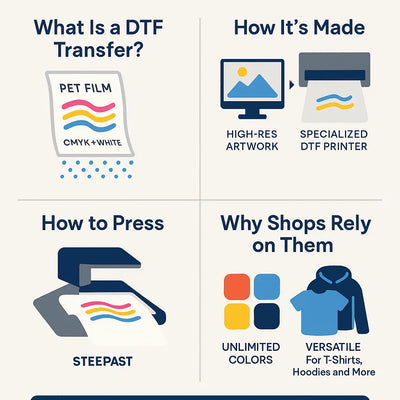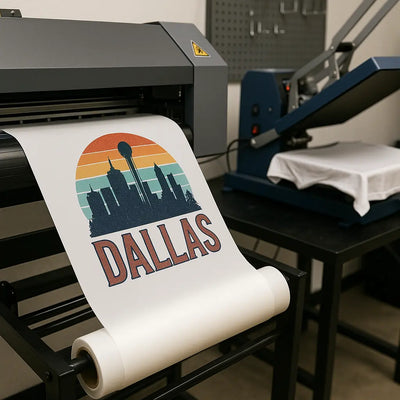

DTF Transfers 101 – Complete Guide to How They Work, How Long They Last, and Why Shops Rely on Them
Jul 23, 2025 (Updated on Sep 26, 2025)
DTF Basics: What Transfers Are, How They Work, and Why Shops Love Them
If you run a print shop—or you’re about to launch one—you’ve probably heard plenty of buzz about DTF transfers. They promise the color range of DTG, the simplicity of heat-press vinyl, and the speed of screen-print transfers, all rolled into one film sheet.
But what is a DTF transfer? How do you actually press it? Does it really outlast heavy wash cycles? And why do so many businesses skip buying a printer and simply order DTF gang sheets from suppliers like DTF Dallas?
Take ten minutes, and you’ll have every answer you need.
1. What Exactly Is a DTF Transfer?
A DTF (Direct-to-Film) transfer is a graphic printed in CMYK + White ink onto a clear PET film. The ink layer is dusted with a granular adhesive powder, then cured in an oven until the powder melts and bonds to the ink. Once cooled, the transfer is ready to ship.
Key features to know
-
Ready to press – Arrives finished; you only need a heat press.
-
Unlimited color – Photographic detail, gradients, and tiny text in a single pass.
-
Fabric freedom – Cotton, polyester, tri-blend, fleece, nylon, canvas—you name it.
-
Shelf life – Stored flat and dry, transfers stay usable for six months or more.
2. How a DTF Transfer Is Made
Step 1 – High-Resolution Artwork
300 dpi PNG or SVG with a transparent background sets the stage. Any color is fair game—no limitations like sublimation’s “poly-only” rule.
Step 2 – Printing on PET Film
A specialized DTF printer lays down white underbase plus full CMYK in a single pass, using flexible, stretch-friendly inks.
Step 3 – Adhesive Powder Application
While the ink is still wet, the film runs through an automatic shaker that coats it in TPU (thermoplastic polyurethane) powder—the secret to wash resistance.
Step 4 – Curing
The powdered sheet rides a conveyor through a 110 °C oven for about two minutes. The powder melts, goes glossy-clear, and bonds to the ink.
Step 5 – Cutting & Packing
Sheets cool, get trimmed or rolled, and head to shipping. At this point they’re dry, handleable, and fully cured—no ink smears, no powder mess.
3. How to Press a DTF Transfer Like a Pro
-
Pre-press the blank
Three seconds at 305 °F removes moisture and wrinkles.
-
Lay the transfer ink-side down
Center it; use heat-resistant tape for tricky placements (sleeves, pockets).
-
Press
Temp: 305 °F (152 °C)
Time: 15 seconds
Pressure: Medium-firm (you should feel solid resistance when locking the press).
-
Cool peel
Move the garment off the platen, let film reach room temp, then peel in a smooth, low angle.
-
Re-press
Cover with parchment or a Teflon sheet, press five more seconds. This melts any micro-bubbles and sinks the graphic into the fibers.
Common mistakes & quick fixes
-
Edge lifting – Increase pressure or add a five-second repress.
-
Dull colors – Verify your press actually hits 305 °F; many run 10 °F low.
-
Visible glue halo – Lower temperature to 300 °F or shorten dwell to 12 s.
4. How Long Do DTF Prints Last?
Pressed correctly, a DTF Dallas transfer survives 50+ home wash cycles:
-
Wash inside-out, cold water.
-
Tumble-dry low or hang-dry.
-
No bleach or fabric softener (same rules you’d give a DTG or screen-print customer).
Laboratory abrasion tests show less than 5 % color fade after those fifty washes—and the print remains flexible instead of cracking.
5. Does DTF Crack?
Not when it’s done right. The TPU adhesive layer remains slightly elastic, even on heavyweight fleece. Cracking usually stems from:
-
Under-pressing (temp or pressure too low).
-
Peeling hot (adhesive hasn’t reset).
-
Skipping the five-second finishing press.
Follow the recipe and the graphic stretches with the garment, whether it’s a workout tank or a 14-oz hoodie.
6. Why Print Shops Choose DTF Over Other Methods
Unlimited Color, One Flat Cost
Screen printing charges per color; vinyl makes multicolor jobs painful. DTF prints every hue at once—perfect for photographic artwork, team jerseys, or gradient logos.
Any Fabric, Any Time
Cotton, dri-fit poly, soft tri-blends? DTF sticks to all of them. Shops can keep one box of transfers on the shelf and press whatever blank the client brings in.
No Pretreatment, No Screens, No Weeding
DTG requires spray and curing; vinyl demands cutting and peeling. A DTF sheet drops those steps entirely.
Low Minimums, Same-Day Turnaround
Order a single left-chest logo or a 22″ × 120″ gang sheet. DTF Dallas offers rush service: upload files by noon, pick up that afternoon—or get overnight shipping.
7. When Might You Choose Something Else?
-
Huge single-color runs (500+ pieces) – Screen print may edge out on cost.
-
Premium polos needing embroidery – Thread still wins for upscale texture.
-
White polyester with no hand feel – Sublimation offers dye-in-fiber softness (but only on white poly).
For almost every small-to-medium, multi-color job—especially on mixed fabrics—DTF is the clear winner in price, speed, and ease.
8. Getting Started Today
-
Download the art template or open the drag-and-drop Gang Sheet Builder.
-
Upload your designs in PNG or SVG.
-
Choose matte or gloss, standard or rush.
-
Press your first shirts tomorrow and watch customers rave about the color pop.
Skip the learning curve, skip the $15,000 printer, and keep your cash for growing the business instead.
Final Word
DTF transfers aren’t just the newest fad—they’re the practical, everyday workhorse many shops have been waiting for: low-cost entry, stunning color, and durability that rivals traditional methods. Give it one job, and you’ll see why printers across Texas and beyond keep a stack of DTF Dallas gang sheets next to their heat press.
Ready to make your first order?
Browse ready-to-press designs or upload your own gang sheet today and turn blank tees into cash in less than 24 hours.
Comments 0
Be the first to leave a comment.




